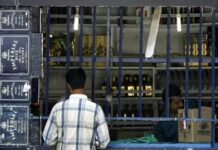Fighting the allegations of discrimination, J&K government managed the passage of a law guiding setting up of J&K State Finance Commission in August 2006. With massive powers to access records, the Commission was mandated to map the resources at district levels, identify backward districts, examine resource devolutions to the regional and district levels, identify employment backlog and formulate a set of administrative measures for reforming decision making in governance and development through decentralized mechanism.
In September 2007, former IAS officer Mehmood-ur-Rehman was appointed as its head with Swami Raj Sharma, Sonam Dawa and Prof Nisar Ali as its members. The Commission submitted its report in November 2010. The commission made some substantial findings though it did not look into all the issues it was mandated. The key findings were:
Recruitments by SSB and PSC
The State Finance Commission (FCom) found out that the Subordinate Services Selection Board made a total of 38414 appointments between 1997 and 2008. Of these 21871 went to Jammu region (56.93%), Kashmir got 16187 (42.13%) and Ladakh got 356 (0.92%). In 2008, Jammu region got more than 71 percent of the selections made by SSRB. On the recruitments made by Public Service Commission, the FCom says: “During 1983 to 2006, 50.97 percent appointments were from the Jammu region and 47.81 percent from Kashmir region and 1.22 percent from Ladakh region.” During the recent period, it said, 52.30 percent PSC jobs were bagged by Jammu leaving Kashmir at slightly more than 45 percent. This goes contrary to the pre-1990 situation when Kashmir would get 56 percent jobs, the FCom noted.
Mean Development Index
Using 265 basic developmental indictors, FCom says compared to 1980-81, the state has improved its mean development index by 20.61 percent. State was assessed to have an index value of 0.3799 in 1980-81 which has now appreciated to 0.4582, an improvement of 0.783 points in 25 years.
 In this period Kashmir region has moved from 0.3481 to 0.4349, an increase by 24.94 percent while Jammu witnessed an improvement in its index value by 42.58 percent (from 0.3039 to 0.4333). The Ladakh belt that is administratively part of the Kashmir province registered an 38.34 percent progress by moving from 0.2432 to 0.3374.
In this period Kashmir region has moved from 0.3481 to 0.4349, an increase by 24.94 percent while Jammu witnessed an improvement in its index value by 42.58 percent (from 0.3039 to 0.4333). The Ladakh belt that is administratively part of the Kashmir province registered an 38.34 percent progress by moving from 0.2432 to 0.3374.
In the aggregate development index Jammu is the main gainer. It has improved its tally in the state from 39.95 percent to 35.94 percent while as Kashmir has compromised its share by going down from 38.88 percent to 36.07 percent. Ladakh is almost stagnant: it had a share of 27.17 percent in state’s aggregate development index in 1980-81 which is at 27.99 percent in 2006-07.
Districts have phenomenally changed their positions. Jammu jumped from third position to first in 25 years as Kathua jumped from sixth to fourth position. Here is the tally.
Road Connectivity
In 1980-81, it was Baramulla district that would top the districts with low road connectivity followed by Kupwara, Islamabad and Leh. Then Poonch had better road connectivity followed by Srinagar, Budgam, Jammu and Kathua. After 25 years, Pulwama has the best road connectivity followed by Budgam, Srinagar and Jammu. Districts with low road connectivity are Leh, Kargil, Doda, Udhampur and Baramulla. Interestingly, in the road development index Kashmir tops the state with Jammu at No 2 and Ladakh at third position.
Access to Potable Water
In 1980-81, nine districts had low access to potable water with Budgam, Baramulla and Kupwara were at the top three positions. All other districts except Kupwara, Doda and Poonch have improved on this front. Islamabad continued to hold the top berth in access to water.
Human Development Index
Jammu region tops the state (0.6981) in HDI and Ladakh continues to retain its third position (0.6165) as Kashmir is in between (0.6065). On this front Jammu is followed by Kathua, Srinagar, Pulwama, Islamabad, Baramulla, Udhampur, Poonch, Budgam, Rajouri, Leh, Kupwara, Doda and Kargil. The deprivation index is the exact reverse of it.
Educational backwardness has slightly shifted. Kargil that topped the list in 1980 is tenth better literate districts now, as Rajouri has improved by 10 positions. Leh has improved substantially as Kathua has overtaken Srinagar pushing it to third position.
Access to Healthcare
In healthcare facilities, Jammu retains the top slot as Pulwama, Kathua and Budgam push Srinagar to fourth position in 25 years. Leh Kargil and Islamabad are the most backward in access to healthcare. Jammu tops the state on region.
Electrification
Compared to 1980 when not a single district was completely electrified, there are four districts which have complete access to power. These are Isalamabad, Srinagar, Budgam, and Jammu while as all other districts are at various stages of getting completely electrified.
Social Sector Development
The levels of social sector development have changed totally. Earlier, Srinagar would lead followed by Pulwama, Budgam, Islamabad, Baramulla and Jammu. Now it is Jammu leading with Budgam, Srinagar, Kathua and Pulwama following the list. Kargil, Leh, Doda and Rajouri are at the tail end of the list.
Resource Allocation
In the 15 years (plan 8-10 from 1992-2007), the per capita expenditure in Jammu was Rs 13980 and Rs 13545 in Kashmir as it worked out at Rs 58517 in Ladakh.













